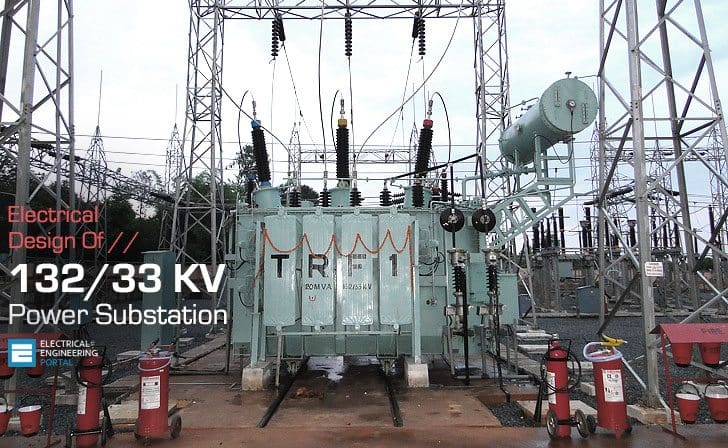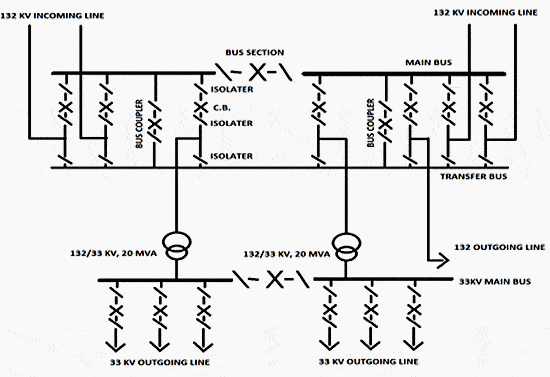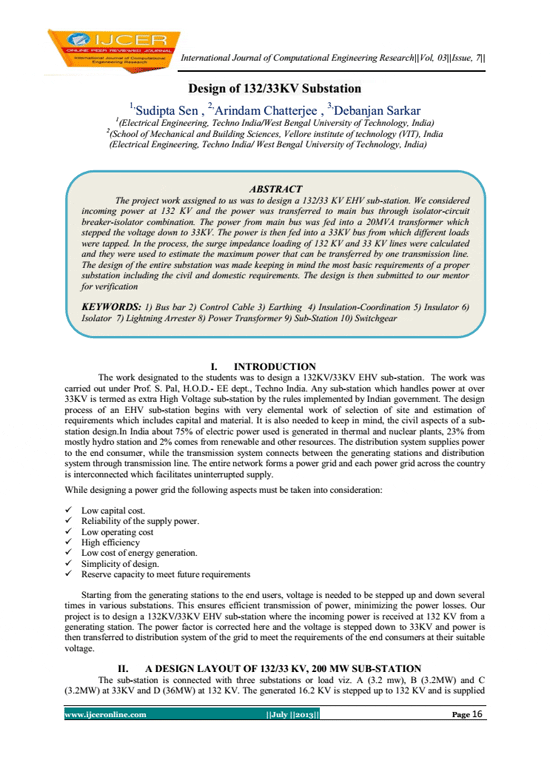132/33 KV EHV substation
The project work assigned to us was to design a 132/33 KV EHV substation. We considered incoming power at 132 KV and the power was transferred to main bus through isolator-circuit breaker-isolator combination.

The power from main bus was fed into a 20MVA transformer which stepped the voltage down to 33KV.
The power is then fed into a 33KV bus from which different loads were tapped. In the process, the surge impedance loading of 132 KV and 33 KV lines were calculated and they were used to estimate the maximum power that can be transferred by one transmission line.
The design of the entire substation was made keeping in mind the most basic requirements of a proper substation including the civil and domestic requirements.

Starting from the generating stations to the end users, voltage is needed to be stepped up and down several times in various substations. This ensures efficient transmission of power, minimizing the power losses. Our project is to design a 132KV/33KV EHV substation where the incoming power is received at 132 KV from a generating station.
The power factor is corrected here and the voltage is stepped down to 33KV and power is then transferred to distribution system of the grid to meet the requirements of the end consumers at their suitable voltage.
| Title: | Design of 132/33KV Substation – Sudipta Sen, Arindam Chatterjee and Debanjan Sarkar // IJCER – International Journal of Computational Engineering Research |
| Format: | |
| Size: | 456 KB |
| Pages: | 13 |
| Download: | Here 🔗 (Get Premium Membership) | Video Courses | Download Updates |



I am doing my final year design project. I have 11 kV system with eight mini-substations. The mini-substation are indicated in kVA ranging from 200 to 500. I am using DIgSilent to draw the schematic. My question is how do I represent the mini-substation on the software.
I’ve sent to your Company a few questions earlier today.
What I’d also like to know, how often do they breakdown ?
Our substations are either being sabotaged or not repaired in the correct way.
Today we’ve had very little power supply to many areas in Pietermaritzburg – at this moment we either have loadshedding again or more repairs done to the substation. Our power is OFF!
Here is another notice received later this evening regarding the faulty subtation.
*Primary Substation Update*
Date: 09/03/2023
Time: 21h45
*Riverside Primary Repairs*
1. 132/33kV Transformer 2 fault at Riverside Primary.
*Affected equipment*
132/33kv Transformer 2
*Affected areas*
City East, Manor, Willowton industrial, Mountainrise, Eastwood, Panorama Gardens, Glenwood, Cinderella, Tamboville, thembalihle, Madiba, Sobantu, Willowton, Wensleydale, Parts of Pelham, Scottsville, Hayfields, Lincoln Meade, Hollingwood, Parts of Bishopstowe, Epworth, Parts of Oribi, Parts of Bisley and surrounding areas
*Corrective Action*
Initiating repairs.
NB: Load Reduction has been implemented in order to protect the Transformer currently in operation.
*Stages to completed*
1. Arrange Resources ✅
2. Arrange Materials in progress✅.
3. Assemble Circuit ✅
4. Erection and installation of 132kv Circuit Breaker ✅
5. Erection of CB poles (Shutdown required)✅
6. Terminating and clamping to the busbar ( Shutdown required) ✅
7. Install and laying of control & Protection cabling is in progress.
8. Testing and Commissioning
9. Energize
Apologies for any inconvenience caused by this crisis
We as a Community of Mzunduzi Municipality would like to know if this is sabotage or genuine faults being experienced by the substation supplying us in Pietermaritzburg?
CAN YOU SEND TO ME TECHNICAL SPECIFICATION FOR 132/33KV MOBILE TRANSFORMER CAPACITY 20 MV
BEST REGARD
ENG. YASIN ABBAS
why usually used the letter E for 132kv cubicles and H for 33kv cubicles and the letter L or AL for 6.6kv cubicles?
I am electrical engineer
I wana to learn,read,about power system and i got some good tips about power system form this port